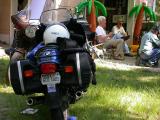Hi all:
Just got a R100RT, and it has a number of small problems that I didn't notice when I bought it. There's a sucker......
The tach/speedo housing (holder?) is cracked. Is there an adhesive that I can use to "weld" the plastic? I'm not sure what kind of plastic it is. I know invisible mending is out of the question, but I would like to strengthen the housing and stop it getting worse.
Any help is appreciated.
Advice on adhesives
Re: Advice on adhesives
NAPA and other parts houses has adhesives that will work
- Ken in Oklahoma
- Posts: 3182
- Joined: Tue Aug 03, 2010 5:10 pm
Re: Advice on adhesives
Welcome to the forum Reggie.
I've had some success repairing thouse housings using epoxy. The repairs haven't been pretty because the epoxy unavoidably squeezes out onto the housing and is quite visible. But my repairs have held. And nobody gets their nose very close to other peoples instrument cluster anyhow. Denatured alcohol is a solvent for uncured epoxy but I haven't tried it to wipe up any excess glue yet.
I've steered away from solvent type adhesives which chemically "melt" the plastic. My main reason was because those repairs look worse than epoxy repairs--at least the way I go about it.
One adhesive that I would avoid would be cyanoacrolayte (sp?). A "water thin" version is available which wicks in to the finest crack and would be a nearly invisible repair. I don't use it because I don't trust it. My experience is that the cured glue, while hard, is also brittle. The vibration and possible flexing of the housing would concern me.
And for damn sure I would never try welding plastic with those kits such as sold by Harbor Freight. I'm sure I would make an ugly mess of things and then it would break.
By the way, what year RT did you buy? I'm a big fan of RT's--but then I'm a big fan of all airheads.
Ken
I've had some success repairing thouse housings using epoxy. The repairs haven't been pretty because the epoxy unavoidably squeezes out onto the housing and is quite visible. But my repairs have held. And nobody gets their nose very close to other peoples instrument cluster anyhow. Denatured alcohol is a solvent for uncured epoxy but I haven't tried it to wipe up any excess glue yet.
I've steered away from solvent type adhesives which chemically "melt" the plastic. My main reason was because those repairs look worse than epoxy repairs--at least the way I go about it.
One adhesive that I would avoid would be cyanoacrolayte (sp?). A "water thin" version is available which wicks in to the finest crack and would be a nearly invisible repair. I don't use it because I don't trust it. My experience is that the cured glue, while hard, is also brittle. The vibration and possible flexing of the housing would concern me.
And for damn sure I would never try welding plastic with those kits such as sold by Harbor Freight. I'm sure I would make an ugly mess of things and then it would break.
By the way, what year RT did you buy? I'm a big fan of RT's--but then I'm a big fan of all airheads.
Ken
____________________________________
There's no such thing as too many airheads
There's no such thing as too many airheads
Re: Advice on adhesives
I had good success fixing cracks in saddlebags with solvent adhesive. The housing and bags are
both ABS plastic. The trick is that the solvent does not fill cracks alone. I took chips of black ABS
from a project I had milled and mixed it with the solvent to make a paste. Force the paste into the crack
and let it cure. It helps, no matter what adhesive you are using, if you slightly chamfer the edges of the
crack ( so if you were looking at the end of the crack, it would look like and hour glass ) .
both ABS plastic. The trick is that the solvent does not fill cracks alone. I took chips of black ABS
from a project I had milled and mixed it with the solvent to make a paste. Force the paste into the crack
and let it cure. It helps, no matter what adhesive you are using, if you slightly chamfer the edges of the
crack ( so if you were looking at the end of the crack, it would look like and hour glass ) .
-
dwerbil
- Moderator
- Posts: 2883
- Joined: Tue Aug 03, 2010 10:58 am
- Location: Round Rock, Texas
- Contact:
Re: Advice on adhesives
I've had luck with epoxy and JB Weld.
Here's my odo gallery if you need some photos.....
http://www.pbase.com/dwerbil/1978_r1007_odometer_repair
Here's my odo gallery if you need some photos.....
http://www.pbase.com/dwerbil/1978_r1007_odometer_repair
CA glue ... epoxy
My experience with CA glue (cyanoacrylate) is quite different than Ken's. I trust it.Ken in Oklahoma wrote:...
One adhesive that I would avoid would be cyanoacrolayte (sp?). A "water thin" version is available which wicks in to the finest crack and would be a nearly invisible repair. I don't use it because I don't trust it. My experience is that the cured glue, while hard, is also brittle. The vibration and possible flexing of the housing would concern me.
First of all, I will say that I have not attempted to repair a tach housing with this type adhesive.
CA is available in different thicknesses to suit different applications.
I buy thin – and add baking soda if a "filler" is needed.
My application of this glue will be structural – Wooden RC boat hull construction.
This one in progress:

These electric powered 32" boats are assembled entirely with CA,
achieve real speeds of 55 - 65+ mph, run in chop,
and do not come apart.
CA adhesive is quite stable, not affected by vibration or water / weather –
A tach housing will not be subject to anything approaching this kind of stress.
Effective use on a tach housing will be determined by the compatability
of the adhesive and the plastic formulation of the housing ...
IMO:
Of all the epoxy formulations available on the market,
JB-Weld has the dubious distinction of being the WORST of any.
Buy a quality epoxy and you will be surprised at it's abilities !
IME:
I have plastic welded BMW body work ( as on the K1 ) with excellent results.

- Ken in Oklahoma
- Posts: 3182
- Joined: Tue Aug 03, 2010 5:10 pm
Re: CA glue ... epoxy
vanzen@rockerboxer.com wrote: . . . My experience with CA glue (cyanoacrylate) is quite different than Ken's. . .
I should have qualified my statement. It reads like a blanket disapproval. Overall I'm a fan of CA. I have used it a lot in my lutherie work and in lother applications. The wicking of the water thin variety solves problems that no other adhesive can, for example a micro crack in a soundboard, or retaining loose frets in their grooves. Many instrument repairmen sing its praises. On the other hand, many luthiers distrust it long term, expressing misgivings about its performance decades down the road.
I've personally experienced two failures with CA. One was plastic on plastic (styrene or a similar plastic) and the other was with a shell inlay in a pendant. The first failure happened years later and it's likely that CA adhesives are better now. The other was with mother of pearl inlayed into an ebony pendant. After about 5 years of continuous wearing the pearl lifted. And when I removed the pieces of shell the residual CA was grainy and brittle. Of course laying for years against an occassionally sweating human body cannot be regarded as a benign environment.
One thing about it, if CA were to fail on an instrument housing I would not expect subsequent repair techniques to be compromised.
Ken
____________________________________
There's no such thing as too many airheads
There's no such thing as too many airheads
Re: Advice on adhesives
I used super glue (ca whatever) to glue my instrument housing together where the three screws mount the housing to the bracket. It had slowly cracked and broken into about 7 or 8 pieces.
I lost a couple of small pieces along the way but the rest has stayed put after gluing, even after the roughest testing on outback roads.
I would like a new housing tho'..........
I lost a couple of small pieces along the way but the rest has stayed put after gluing, even after the roughest testing on outback roads.
I would like a new housing tho'..........
Lord of the Bings
Re: Advice on adhesives
Thanks for all the advice.
Once I remove the housing I'll have a closer look at the degree of damage and decide based on the advice you've all offered. I'd originally considered epoxy but wasn't sure if it would bond to that type of plastic. However, the adherents of cyanoacrylate have got me thinking.
I'll post my results later. Again, thanks for the contributions to solving the problem.
By the way Ken, it's a '92 R100RT with nivomat rear shock.
Once I remove the housing I'll have a closer look at the degree of damage and decide based on the advice you've all offered. I'd originally considered epoxy but wasn't sure if it would bond to that type of plastic. However, the adherents of cyanoacrylate have got me thinking.
I'll post my results later. Again, thanks for the contributions to solving the problem.
By the way Ken, it's a '92 R100RT with nivomat rear shock.
-
dwerbil
- Moderator
- Posts: 2883
- Joined: Tue Aug 03, 2010 10:58 am
- Location: Round Rock, Texas
- Contact:
Re: Advice on adhesives
To be on the safe side, after gluing your cover, give it a length of time to out-gas a bit before putting it all back together.
